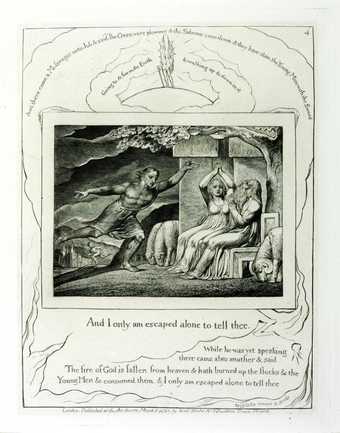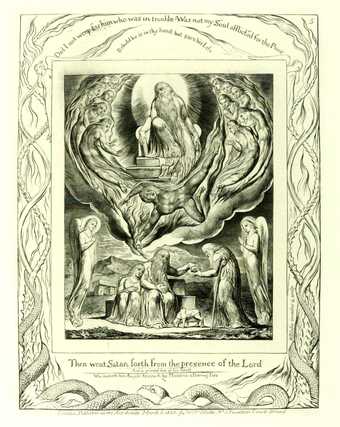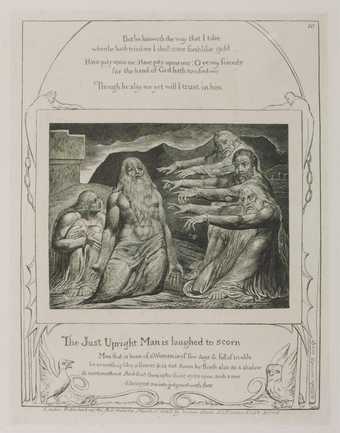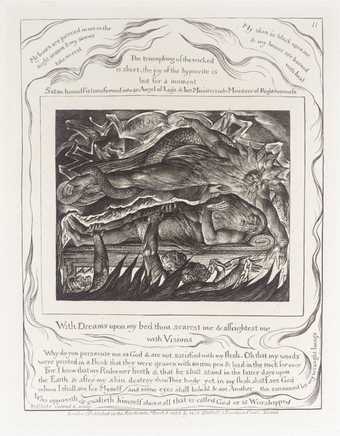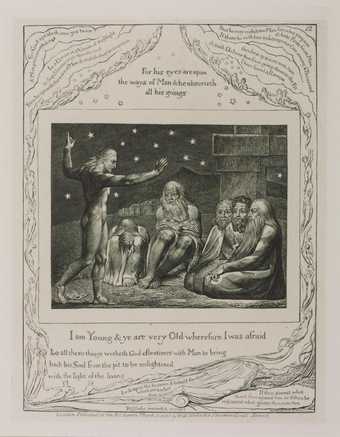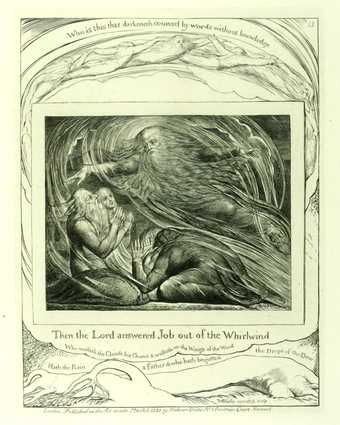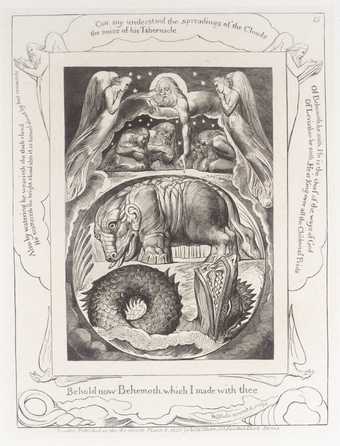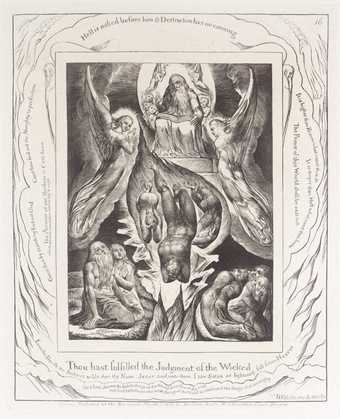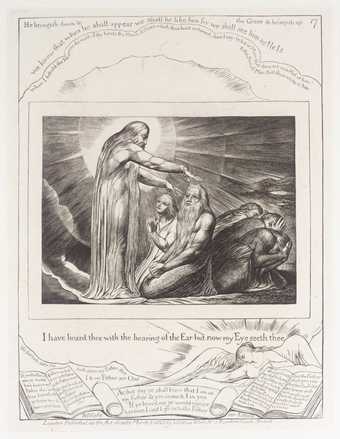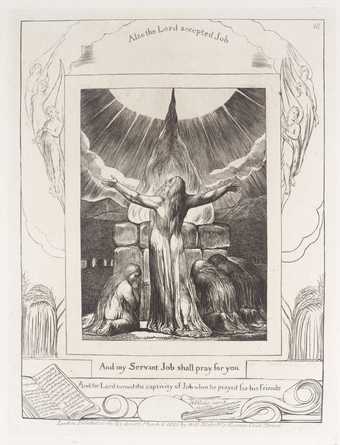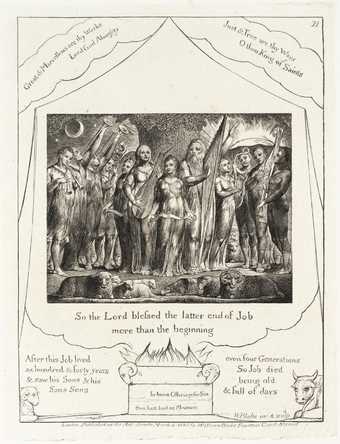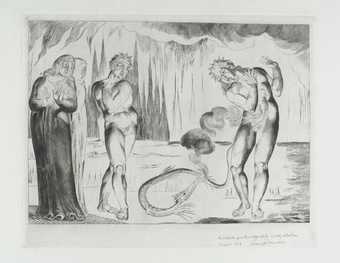
In Tate Britain
Prints and Drawings Room
View by appointment- Artist
- William Blake 1757–1827
- Medium
- Line engraving on paper
- Dimensions
- Image: 191 × 150 mm
- Collection
- Tate
- Acquisition
- Purchased with the assistance of a special grant from the National Gallery and donations from the Art Fund, Lord Duveen and others, and presented through the Art Fund 1919
- Reference
- A00025
Catalogue entry
A00025 [from] Illustrations to The Book of Job: Engravings
1823–6/1874 [A00012-A00032; T05845; complete]
A 00012–32 /-
Twenty-two line engravings on india paper laid on drawing paper approx. 510×345 (20×13 1/2)
Purchased with the assistance of a special grant from the National Gallery and donations from the National Art-Collections Fund, Lord Duveen and others, and presented through the National Art-Collections Fund 1919
PROVENANCE John Linnell; his heirs, sold Christie's 15 March 1918 (183) £33.12.0.bt Martin for the donors
LITERATURE Gilchrist 1863, 1, pp.283–4, 297; Wicksteed 1910 and 1924; Russell Engravings 1912, 102–15 no.33: Keynes Bibliography 1921, pp.179–82 no.55: Binyon and Keynes 1935, series repr. vol.VI; Keynes Engravings 1950, pp.16–17, series repr.pls. 42–68; Keynes Writings 1957, pp.869–70, 872, 874, 876–7; S. Foster Damon, Blake's Job 1966, series repr.; Bentley Blake Records 1969, pp.234 n.i, 277–397 passim, 586–605; Andrew Wright Blake's Job: A Commentary 1972, series repr.; Lindberg 1973, pp.24–32, 40–52, 167–76, 183–352 nos.0A–21A, series repr.; Bentley Blake Books 1977, pp.517–24 no.421; Bindman Graphic Works 1978, pp.486–7 nos.625–46, series repr.; Mitchell 1978, pp.41–2; Essick Printmaker 1981, pp.92, 105, 220, 234–50, 252; Robert N. Essick, ‘Blake's Engravings to the Book of Job; An Essay on their Graphic Form with a Catalogue of their States and Printings’ in David Bindman, ed., William Blake's Illustrations of the Book of Job 1987, pp.35–101.
John Linnell, who had commissioned the second set of watercolour illustrations to the Book of Job in 1821, entered into a formal agreement with Blake for the engravings on 25 March 1823: Linnell was to pay Blake £5 a plate or £100 for the set, and in addition he agreed to give Blake an extra £100 if the profits of the work made this possible. The agreement was for twenty engravings though in the event twenty-one subjects were engraved together with a title-page. On 5 March 1825 Linnell went with Blake to the printer J. Lahee to see proofs being taken. The series is dated 8 March 1825 but the final engravings do not seem actually to have been ready until the end of March 1826 (Bentley 1969, pp.277, 300 and 327). At this time 215 sets of engravings marked ‘Proof’ were issued; these should be distinguished from the working proofs, on some of which Blake tried out designs for the borders. The word ‘Proof’ was then deleted (traces can be seen on A00013) and a further 100 sets were printed on drawing paper. According to John Linnell Jr, writing to Bernard Quaritch on 6 May 1892, Linnell, after the 1826 printing, ‘put the plates away, & they were never again used after this time until the year 1874. At this time my father...had one hundred copies printed from the plates upon India paper’. Although the distinctive cover is now missing, it seems that the Tate Gallery's copies of the engravings are from this 1874 printing. The original plates were given by Herbert Linnell to the British Museum Print Room on 28 May 1919.
Each engraving is inscribed ‘W Blake inv. & sculp’. In addition each is inscribed in the lower margin with variations of the text ‘London. Published as the Act directs March 8:1825 by William Blake No3 Fountain Court Strand’; the first actual design (A00012) is mistakenly dated with the year 1828 and ‘Willm’ is sometimes substituted for ‘William’, while the punctuation is also slightly varied.
More importantly, the borders of each design bear a number of inscriptions taken from the Bible or with variations of biblical texts. These add a verbal gloss to the designs which in themselves embody Blake's critical reaction to the original story as set out in the Old Testament. The fullest analysis is in Lindberg though Wicksteed, Damon 1966 and Wright also contain full commentaries. Blake's interpretation of his text is only given in summary form in this catalogue.
These engravings were formerly inventoried as nos.3372 i–xxii. The new inventory numbers omit the title-page.
A00025 When the Morning Stars Sang Together
Line engraving 191×150 (7 1/2×5 7/8); platemark 207×164 (8 3/16×6 7/16)
Inscribed ‘WBlake Invenit & Sc’ b.l., ‘London. Published as the Act directs March 8: 1825 by Willm Blake N3 Fountain Court Strand’ below, ‘14’ t.r., and with texts given below
EXHIBITED Tate Gallery 1958 (205, repr.)
Illustration no.14: Job, xxxviii, 4–7. Blake's main text is ‘When the morning Stars sang together. & all the/Sons of God shouted for joy’ (Job, xxxviii, 7); in the third state of the engraving these words were preceded, as in the Bible, by ‘When I laid the Foundations of the Earth’ with ‘And’ replacing the initial ‘When’, and Lindberg suggests that Blake deleted these words to indicate that this state of joy only related to the upper part of the composition, referring to the time of eternity before creation. In the upper margin Blake quotes the Lord's question ‘Canst thou bind the sweet influences of Pleiades or loose the bands of Orion’ (Job, xxxviii, 31). In each of the flanking margins there are little scenes of creation, each with its own inscription: ‘Let there be/Light’ (Genesis, i, 3); ‘Let there be A/Firmament’ (Genesis, i, 6); ‘Let the Waters be gathered/together in one place & let the Dry Land appear’ (Genesis i, 9); ‘And God made Two Great/Lights/Sun Moon’ (Genesis, i, 16); ‘Let the Waters bring/forth abundantly’ (Genesis, i, 20); ‘Let the Earth bring forth/Cattle & Creeping thing/& Beast’ (Genesis, i, 24).
This is the first of a sub-group of three compositions in which God reveals to Job the creation, the organisation and the annihilation of the natural world. The angels or ‘morning stars’ exist in eternity above, while Job, his wife and his friends are shown in a cave-like Earth below. In between, in a zone partly occupied by the Lord, are the Sun and Moon gods representing time, identified by Lindberg as Helios and Selene rather than Apollo and Diana.
The figures of Helios and Selene are probably derived from Antique gems, which Blake on his Laocoön print of c.1818–20 equated with ‘The Gems of Aaron's Breast Plate’ (Keynes Writings 1957, p.777; repr. Bindman 1978, pl.623, Essick Separate Plates 1983, pl.51). Indeed, Lindberg suggests that this whole design is a reconstruction by Blake of Aaron's breastplate, which was understood in the eighteenth century to represent the original map of the universe.
The motif of angels with upstretched arms crossing each other to form a frieze had already been used by Blake in one of his illustrations to Young's Night Thoughts of c.1795–7 (Butlin no.330 437; repr. Blunt 1959, pl.54b, and Grant, Rose and Tolley 1980). It is probably based on a relief from Persepolis engraved for Jacob Bryant's New System of Ancient Mythology in Basire's workshop 1775–6 when Blake was an apprentice there (repr. Blunt 1959, pl.54a). The motif reappears in the second illustration in Blake's two series of illustrations to Milton's On the Morning of Christ's Nativity of 1809 and c.1815 (Butlin nos.538 2 and 542 2, repr. in colour pls.661 and 667). In the Job engraving, as opposed to the preceding watercolours, Blake added further arms cut by the edge of the composition, suggesting an infinitude of angels in eternity.
Published in:
Martin Butlin, William Blake 1757-1827, Tate Gallery Collections, V, London 1990
Explore
- emotions, concepts and ideas(16,416)
-
- universal concepts(6,387)
-
- creation(29)
- actions: postures and motions(9,111)
-
- arm / arms raised(839)
- kneeling(502)
- Bible: Old Testament(381)
-
- Job(24)
- Job’s wife(13)
- Job, chapter 38(2)
- God(152)
- angel(267)
- transport: land(2,189)
-
- chariot(21)
- abstract concepts(119)
- religious(17)
You might like
-
William Blake The Serpent Attacking Buoso Donati
1826–7, reprinted 1892 -
William Blake Satan before the Throne of God
1825, reprinted 1874 -
William Blake The Messengers tell Job of his Misfortunes
1825, reprinted 1874 -
William Blake Satan Going Forth from the Presence of the Lord, and Job’s Charity
1825, reprinted 1874 -
William Blake The Vision of Eliphaz
1825, reprinted 1874 -
William Blake Job Rebuked by his Friends
1825, reprinted 1874 -
William Blake Job’s Evil Dreams
1825, reprinted 1874 -
William Blake The Wrath of Elihu
1825, reprinted 1874 -
William Blake The Lord Answering Job out of the Whirlwind
1825, reprinted 1874 -
William Blake Behemoth and Leviathan
1825, reprinted 1874 -
William Blake The Fall of Satan
1825, reprinted 1874 -
William Blake The Vision of Christ
1825, reprinted 1874 -
William Blake Job’s Sacrifice
1825, reprinted 1874 -
William Blake Job and his Family Restored to Prosperity
1825, reprinted 1874 -
William Blake The Serpent Attacking Buoso Donati
1826–7, reprinted 1968



